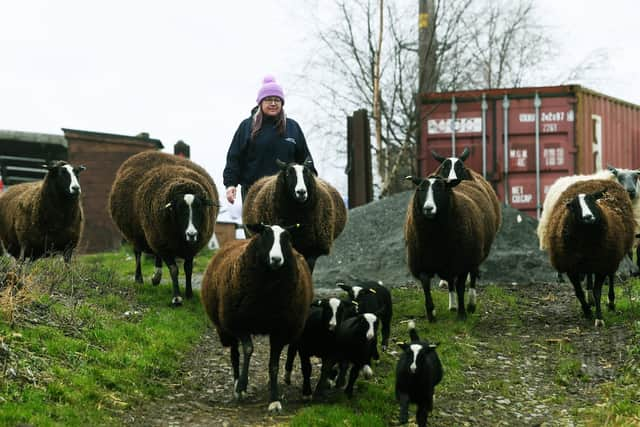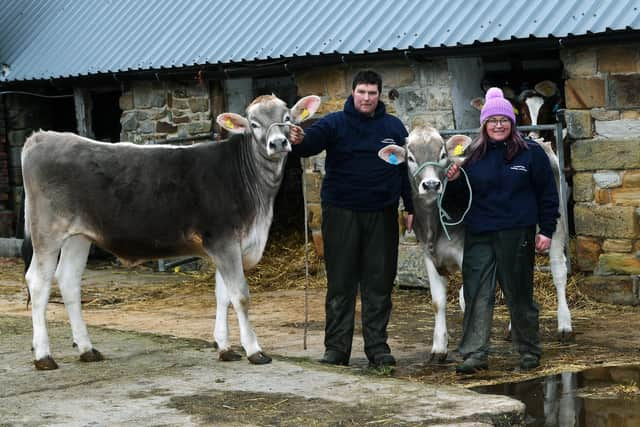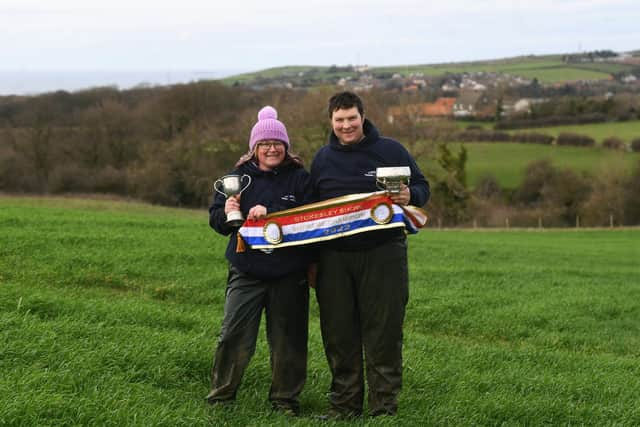Farm of the Week: Show champion couple back in dairying after past trauma in the milk supply business
I first spoke with John and Alison of Blue House Farm in Liverton last summer while they were at Ryedale Show where the happy couple were enjoying a successful day with Alison’s Zwartbles flock. It was to be the end of the summer show season when John joined the party taking interbreed champion with his Ayrshire cow in milk at Stokesley Show, marking a triumphant return to the dairy show ring for the first time in eleven years.
Alison recently reported on a rubbish start to 2023 on her Liverton Zwartbles Facebook page when the polytunnel she uses for her sheep had been blown apart by strong winds at Blue House Farm and told me that the saying ‘there’s light at the end of the tunnel’ was certainly true in her case!
Advertisement
Hide AdAdvertisement
Hide Ad“If you do a high and low on this rollercoaster ride we are on, the highs for 2022 were John showing his Ayrshire at Stokesley and getting champion interbreed; my Liverton Zwartbles taking the breed’s Northern Branch Small Flock Award; and the low was finishing the year with the polytunnel debacle.


“It has been a massive life-changing experience for me these past ten years, coming into farming and moving from Durham with my two sons Aaron and Nathan. There are so many highs and lows in farming. At times it is extremely difficult, but at most other times it is the best thing I’ve ever done.
John can’t hide his smile since coming back into dairying from what were those dark days that led to the end of the dairy enterprise with his dad Phil in 2010.
“It’s in your blood isn’t it? I like my cows. I like working with them. I’m 37 now. I was 26 when we were forced out of dairying. We had been struggling along.
Advertisement
Hide AdAdvertisement
Hide Ad“We were on our knees. We were in a real old set up. It was tired. We invested in it with a new parlour and a new shed and then the milk price collapsed. Our milk was going to a little local dairy that let us down. Father went to the bank we were with at the time and they just said you’re on your own.


John and Phil took on work away from the farm for a while but a gradual return to livestock led to John’s return to dairying three years ago.
“We tried a bit of allsorts. We raised calves under the Buitelaar system for a while and then we started buying calves at the now closed Beeston Castle livestock market in Cheshire at the time when you could pick Angus heifer calves up at a decent price. We would then take everything up to Carlisle as stores.
“We were able to set off with a new dairy herd thanks to two main sources. Chris Day of Alchemy Finance, who has gone through everything with us and has helped us throughout; and my brother Rob who has done such a lot for us. He has the farm machinery company Agriplus that sells McCormick tractors.
Advertisement
Hide AdAdvertisement
Hide Ad“I’m still in a farm partnership with my parents Phil and Sue, but I took over the running of the farm that runs to 185 acres with Alison when we started back up with milk cows again in 2020.


John loves dairy cows and going back into dairying has seen him come back with fresh ideas, notably a different breed that he believes has the potential to become one of the largest dairy breeds in the UK in the years to come.
“When we were last in dairy farming we had Ayrshires and Black & Whites, but while we were on with the calving game we took on a couple of Brown Swiss bull calves, reared them and they did real well.
“Brown Swiss dairy cows are not that popular in the UK just yet, but they are becoming more so. If they are pushed right, marketed right, they could definitely get up to being the number two dairy breed in the country and it might take some time, but they could even push the Black & Whites.
Advertisement
Hide AdAdvertisement
Hide Ad“It’s their longevity. They don’t give as much as heifers at the start, but that’s because they are still maturing. It’s after that, when you’re getting into eight, nine or ten lactations and they are booming out 9000-10,000 litres. It means you need less replacements.
John said he currently has 75 dairy cows and only just over a handful are Brown Swiss.
“It’s a pick ‘n’ mix herd at the minute, a bit Heinz 57 varieties, but the 8 Brown Swiss and 25 Ayrshires form the basis of the herd that I would like to take to 90 per cent Brown Swiss and 10 per cent Ayrshire in the next six years.
“We picked up the bulk of our Ayrshire cows from Cornwall, with the Brown Swiss and rest of the Ayrshires bought out of Harrison & Hetherington at Carlisle for us by Dr Reynolds.
Advertisement
Hide AdAdvertisement
Hide Ad“I’m using Brown Swiss sexed semen from Mastergen across 60 per cent of the herd. Mastergen collects from Brown Swiss cows all across Europe including Switzerland and also in America. We’ve some nice Brown Swiss to calve down for next year.
“Our current average yield per lactation is 8000 litres across the herd with 4.7 butterfat and 3.6 protein.
“My aim is to get to 85 cows milking and selling more surplus heifers at Carlisle every month. We currently have two or three heifers a month going up there. We’re using beef bull semen on the rest of the herd. We have Mastergen’s Inra 95 beef breed. I jumped on this as it is fertile and easy calving. They come out and grow like mushrooms.
John’s success at Stokesley was no flash in the pan either. He had Ayrshire champion at the Great Yorkshire Show in 2004.
Advertisement
Hide AdAdvertisement
Hide AdAlison started her Zwartbles flock when she bought three in 2013. She also has Bleu du Maines.
“Mr Stocksman chooses my tups,” said Alison. “We won at Ryedale, Masham and the Northern Area Small Flock competition last year. I’ve managed to do it with John’s knowledge of pedigree livestock breeding and being the determined so-and-so I am. We’ve done really well with them winning breed championships since 2015. I like to get the reward of being placed. It makes all the hard work worthwhile.
“We show at North Yorkshire County, Otley, Masham, Aldborough & Boroughbridge, Nidderdale and Westmorland. We’ve been at the Great Yorkshire too, and when we have we’ve always sold something there.
John said that stocksmanship is in the eye of the beholder.
“You don’t need a big cheque book, all you need is a good pair of eyes. If you’re a proper stocksman you can see quality, whatever the species.